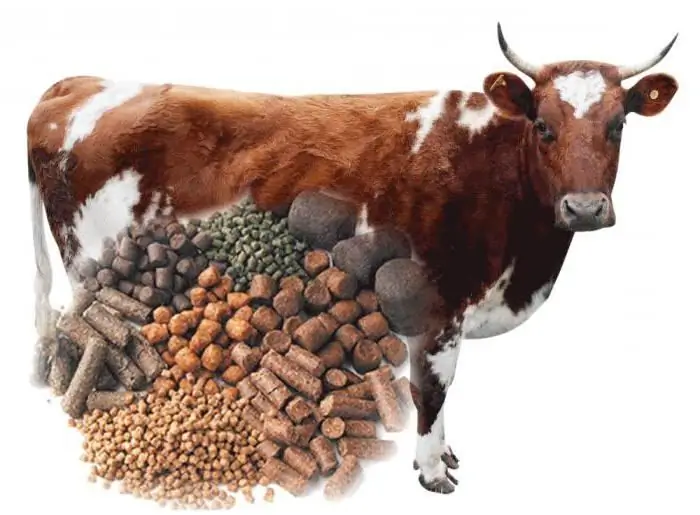2026 Author: Howard Calhoun | [email protected]. Last modified: 2025-01-24 13:10:43
In the late 70s and 80s, such branches of agriculture as poultry and livestock began to gain momentum in the Udmurt Republic. In this regard, the region has a need for feed. To solve this problem, the construction of a plant for the production of animal feed was laid. And by 1986, the Glazov Feed Mill (GKZ) was launched. At that time, its capacity was about 700 tons of products per day.

Beginning history
In 1979, the construction of the plant began. In 1984, the first elevator was launched, which produced combined feed. The design capacity allowed the plant to produce up to 735 tons of products per day. The Glazovskiy Feed Mill sold the bulk of its products to poultry farms, collective farms and pig-breeding complexes in Udmurtia.
In the early 90s, due to the negative economic situation in our country, many agricultural enterprises lost theirsolvency. Following this, the plant significantly reduced production volumes and was close to bankruptcy. From 1996 to 2000, the GKZ was idle without work. So, in 2000, only 2 tons of compound feed were produced. In the same year, the first batch of protein-vitamin supplements with minerals was released. The volume of output was only 4 tons. The main goal is to conduct test trials. It was this experiment that proved that Glazovsky Feed Mill LLC is one of the promising Russian enterprises in this direction.
Since 2007, the GKZ has been part of the Komos Group holding and is now working under its leadership. "Komos Group" consists of 12 enterprises that produce food in the Perm Territory and Udmurtia. These are 5 poultry factories, 4 milk processing enterprises, 2 large pig-breeding complexes and 1 feed mill. All of them are the largest in their segment of the agricultural market in the region.
What does the factory produce
GKZ produces feed for pigs, cattle, geese, chickens and chickens, ducks, turkeys. The list of products produced by the factory includes:
- feed;
- compound feed;
- forage;
- mineral supplements;
- feed additives;
- protein-vitamin supplements;
- amino acids for forage enrichment;
- granular food;
- vitamin supplements.
In addition, the Glazovsky Feed Mill provides consultations on the preparation of diets for livestock and poultry, and makes recommendations.

In Russia, feed produced by the Glazovsky feed mill is considered one of the best, reviews of which are constantly published in the media. The quality of the products allows the manufacturer to compete confidently in the market with other manufacturers. GKZ ranks fourth in the country in terms of feed balance, and second in feed safety.
Customer Base
Thanks to a wide range of compound feed produced, the plant cooperates with many regions of our country. GKZ is constantly increasing volumes, developing steadily and attracting a new customer base. Compound feed is in demand not only in the Udmurt Republic, but also abroad: in the Perm Territory, Astrakhan and Nizhny Novgorod regions, Bashkortostan, Mari El, Kirov region, Chuvashia and others.

Awards
The company improves its production technologies every year, therefore it regularly receives awards. Thus, the GKZ was awarded the highest award of Russia in the field of food "For the prosperity and abundance of Russia." In 2010, the plant received a diploma of the 1st degree at the international exhibition “Grain. Compound feed. Veterinary - 2010" in the nomination "Mixed feed and premixes".
For several years in a row, the Glazovsky feed mill has been recognized as the winner in the Russian competition of high social efficiency in the nomination "For the development of the labor market in industrial organizations."
Recommended:
Mini feed mill: key features and reviews

Why is it necessary to install a mini feed mill in the production of milk and meat? Classification and principle of operation of such equipment, reviews about it
Real estate development and its role in economic development. The concept, types, principles and foundations of development

In the framework of this article, we will consider the organization of the real estate development system and its role in economic development. The basic concepts, types and principles of organization of the development system are considered. The characteristic features of the system in Russian conditions are considered
Organizational structure of business and its development

The most important issue in any successful project is the structure of the business. After reading this article, you can easily evaluate your business development strategy and, if necessary, adjust it
Forage wheat grade 5. Feed for farm animals. feed grain

Feed grains are cereals intended for feeding farm animals. Forage is the basis of diets in poultry and pig breeding, as well as a valuable component in cattle breeding. Such crops cannot be used for food purposes
How to feed horses: types of feed, nutritional rules and diet

To figure out what to feed horses, it would not hurt to find out how these animals eat in the wild. In ancient times, herds of horses simply grazed in the meadows. This was enough to provide their body with all the necessary nutrients

